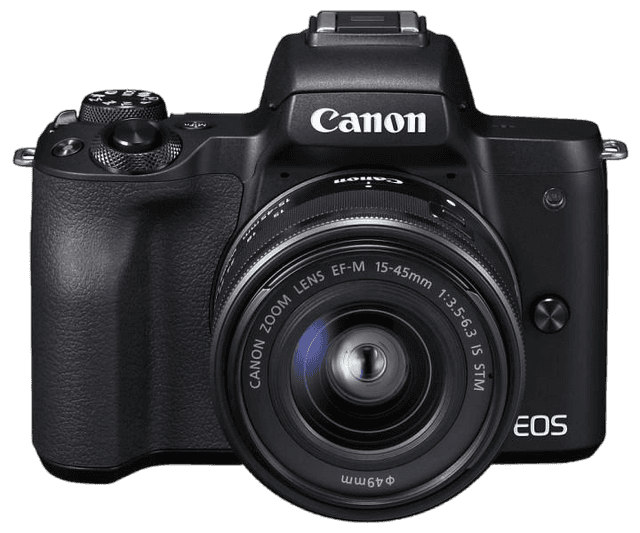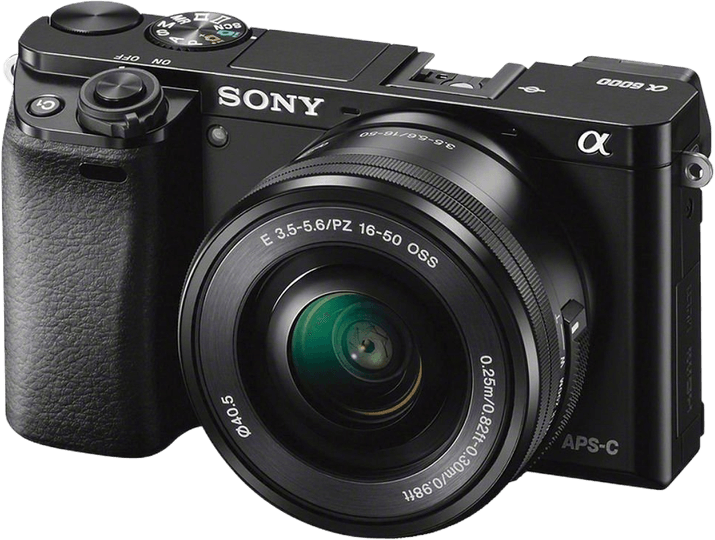Canon EOS M50 vs Sony a6000 Comparison
Canon EOS M50

Sony a6000

The Canon EOS M50 takes the lead with a score of 59/100, while the Sony a6000 trails closely behind at 57/100. Both cameras are mirrorless and were released in 2018 and 2014, respectively. They share similar launch prices, with the M50 at $779 and the a6000 at $799.
The Canon EOS M50 excels with its slightly larger dimensions (116 x 88 x 59mm) and heavier weight (390g / 0.86lbs), providing a more robust feel. On the other hand, the Sony a6000 boasts a more compact design (120 x 67 x 45mm) and lighter weight (344g / 0.76lbs), making it more portable and travel-friendly.
Considering their specifications, the Canon EOS M50 is a better choice for those who prefer a sturdier build, while the Sony a6000 is ideal for photographers seeking a lighter and more compact camera.
Canon EOS M50 vs Sony a6000 Overview and Optics
The Sony a6000 outperforms the Canon EOS M50 in optics, scoring 67/100 compared to the M50’s 59/100. Both cameras share several specifications, including 24-megapixel resolution, CMOS sensor type, APS-C sensor size, and lack of image stabilization. Additionally, both cameras have their respective lens mounts – Canon EF-M for the EOS M50 and Sony E for the a6000.
The Sony a6000 has a slight advantage in shooting speed, with 11 frames per second (fps) compared to the M50’s 10 fps. More notably, the a6000 boasts a higher DXOMARK score for its sensor at 82, while the M50 scores 58. This difference indicates better overall image quality from the Sony a6000. Furthermore, the Sony a6000 utilizes the Bionz X processor, which is known for its impressive speed and performance.
On the other hand, the Canon EOS M50 has the Digic 8 processor. While it may not be as powerful as the Bionz X, it still provides decent performance. The M50’s lens mount, Canon EF-M, offers compatibility with a wide range of Canon lenses, making it a versatile option for photographers with existing Canon gear.
Taking all these factors into account, the Sony a6000 emerges as the superior camera in terms of optics, thanks to its better sensor quality and faster processor. However, the Canon EOS M50 remains a viable option for those who prioritize lens compatibility and have an existing collection of Canon lenses.
Canon EOS M50 vs Sony a6000 Video Performance
The Canon EOS M50 emerges as the winner in the video capabilities comparison, scoring 91 out of 100, while the Sony a6000 scores only 56 out of 100. Both cameras share some video specifications, but the Canon EOS M50 excels in certain areas, making it the superior choice for video recording.
Both the Canon EOS M50 and Sony a6000 have max video resolutions of 4K and Full HD, respectively. The Canon EOS M50 has a max video dimension of 3840 x 2160, while the Sony a6000’s max video dimension is 1920 x 1080. The Canon EOS M50’s max video frame rate is 120fps, whereas the Sony a6000 has a max video frame rate of 60fps. The Canon EOS M50 also has a built-in time-lapse functionality, a feature the Sony a6000 lacks.
The Canon EOS M50’s higher max video resolution, dimensions, and frame rate make it a better choice for those seeking high-quality video recording. The built-in time-lapse functionality is an added bonus, allowing users to create stunning time-lapse videos with ease.
The Sony a6000, on the other hand, does not offer any clear advantages over the Canon EOS M50 in terms of video capabilities. Its lower max video resolution, dimensions, and frame rate make it less suitable for those prioritizing video quality.
As a result, the Canon EOS M50 is the better choice for video recording, with its higher max video resolution, dimensions, and frame rate, along with built-in time-lapse functionality. The Sony a6000 does not provide any significant advantages in this area, making the Canon EOS M50 the clear winner in terms of video capabilities.
Canon EOS M50 vs Sony a6000 Features and Benefits
The Canon EOS M50 emerges as the winner in the features comparison with a score of 70/100, while the Sony a6000 scores 41/100. Both cameras have a 3-inch screen, a flip screen, no GPS, and WIFI capabilities.
The EOS M50 outperforms the a6000 in several aspects. Firstly, it has a higher screen resolution of 1,040,000 dots, compared to the a6000’s 921,600 dots. This results in a sharper and clearer display, providing a better user experience. Secondly, the EOS M50 has a touchscreen, which the a6000 lacks. This makes navigation and operation more intuitive and user-friendly. Lastly, the EOS M50 has Bluetooth connectivity, allowing for seamless and convenient connection to other devices.
On the other hand, the Sony a6000 has only one advantage over the EOS M50: it has a flip screen. This feature allows for greater flexibility when composing shots, particularly in challenging angles. However, this advantage is not enough to outweigh the benefits offered by the EOS M50.
In terms of features, the Canon EOS M50 is the clear winner, offering a higher screen resolution, touchscreen capabilities, and Bluetooth connectivity. These features contribute to a more enjoyable and efficient user experience. The Sony a6000 falls short in comparison, with its only advantage being the flip screen. As a result, the EOS M50 is the better choice for those seeking a camera with superior features.
Canon EOS M50 vs Sony a6000 Storage and Battery
The Sony a6000 outperforms the Canon EOS M50 in storage and battery with a score of 21 to 13. Both cameras have one memory card slot and do not support USB charging. They accept SD, SDHC, and SDXC cards, but the Sony a6000 also accepts Memory Stick Pro Duo and Pro-HG Duo cards, providing more storage options.
The Sony a6000’s battery life is superior, offering 360 shots compared to the Canon EOS M50’s 235 shots. This longer battery life allows photographers to capture more images without worrying about recharging or changing batteries. The Sony a6000 uses the NP-FW50 battery type, while the Canon EOS M50 utilizes the LP-E12 battery type.
The Canon EOS M50 does not have any advantages in storage and battery over the Sony a6000. The Sony a6000’s longer battery life and additional memory card compatibility make it the better choice in terms of storage and battery capacity.
Canon EOS M50 vs Sony a6000 Alternatives
Still not sure which camera is best for you? Check out some other popular camera comparisons for inspiration:
